
The universe has evolved to create a species capable of partially understanding it: humans.
From the chaotic beginnings to the space age, as the only known intelligent life, humans have used various tools to understand and transform the world, achieving the continuation of species and the evolution of civilization.
However, in today’s rapidly developing artificial intelligence technology, why do we still send humans into space? How do humans and machines collaborate in space missions? As a human-involved space activity, how does crewed spaceflight inject and elevate the value of “humans”?
Crewed spaceflight is a complex engineering project composed of multiple systems, and it is also a system engineering built by humans, machines, and the space environment. Beyond reflecting national will, uplifting national spirit, promoting technological progress, and continuing future civilization, this article discusses the role of humans in space from the perspective of a space station engineer, as well as the system design conducted in crewed spaceflight to meet human needs in space.
The preciousness of humans is irreplaceable; putting people first, space exploration begins with the original intention.
Part One: Irreplaceable Humans: The Extraterrestrial Mission of Intelligent Species
“Using horses and carts does not rely on the strength of the legs, but achieves thousands of miles; using boats and oars does not rely on the ability to swim, but crosses rivers and lakes.” More than two thousand years ago, our ancestors summarized the significant extension of human capabilities through tools such as mules and boats.
Since the Industrial Revolution, the tools available to humans have further developed into automated devices, robots, and artificial intelligence (hereafter referred to broadly as “machines”). The application of machines has not replaced human labor but has instead spawned more jobs in specialized divisions of labor, industrial chains, and third-party services across numerous fields.
At the dawn of the space age, space pioneer Wernher von Braun believed that one of the main tasks for humans in the space station was to replace camera film. Today, whether observing the Earth or the sky, film is no longer used, yet humans in space have not become unemployed; instead, they have more, more complex, and more meaningful jobs, with the astronaut profession even subdivided into roles such as scientists and engineers.
Can machines replace humans? This fresh yet ancient topic already has answers. For centuries, from Earth to the cosmos, technology has continuously advanced, but the work that humans can do has surpassed the capabilities of contemporary machines, or has evolved higher demands based on those capabilities. While machines can complement or replace some human labor, they allow humans to free their hands and minds to engage in more “advanced” tasks. “Advanced” is relative to the era, but the unique abilities that humans possess, transcending machines, are independent of the era; thus, crewed spaceflight will always be designed with “humans” as the starting point.
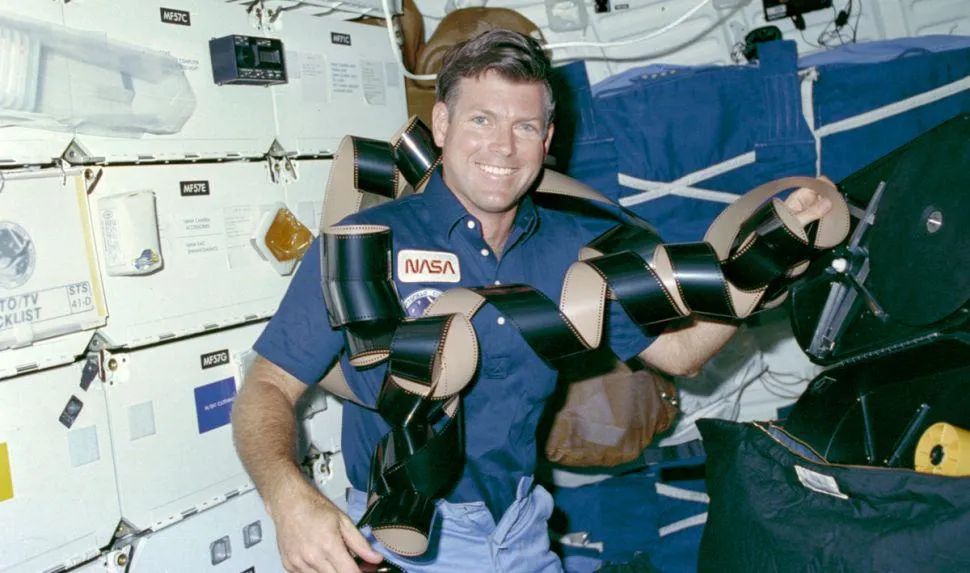
▲ In the 1984 Space Shuttle STS-41-D mission, astronaut Michael L. Coats removed film from a stuck IMAX camera. (Image source: Space.com/NASA)
1. The Difference of Humans on Site
Space teleoperation has become a fundamental method for humans to conduct space activities, but on-site human participation can achieve more efficient and direct operational results and more comprehensive, rich outcomes. Typical work sites include scientific research and technical experiments, operation of the space station, and assembly and construction of the space station and other on-orbit facilities. Their common characteristic is that professionals with knowledge and skills can make comprehensive judgments based on diverse information from the site, make targeted decisions in real time, and implement physical operations.
(1) Scientific Research and Technical Experiments
This type of work is exploratory, iterating through the process of “trial-evaluation-correction-retrial.” Humans on site can obtain comprehensive experimental information in real time, make judgments about the current state, and thus formulate the next work plan, adjusting and determining experimental status and parameters. Compared to ground expert teams that can only rely on limited telemetry data, payload expert astronauts on site can make comprehensive judgments and efficient decisions using rich state information.
On-site experts can also directly replace experimental samples, adjust test pieces, or alter the status of experimental facilities. These operations must be “visible and tangible” to be performed—at least, based on current technological capabilities, it is much more constrained and difficult for ground personnel to achieve the same effects through remote control.
Within the space station, the configuration of high-performance computers and the development of on-orbit 3D printing and in-situ material processing technologies will further enhance the ability of on-site personnel to engage in experiments. Relying on the Earth-space link, crewed space activities can form a working model that combines on-orbit experiments by payload experts with technical support from ground professional centers, fully utilizing the strengths of both Earth and space.
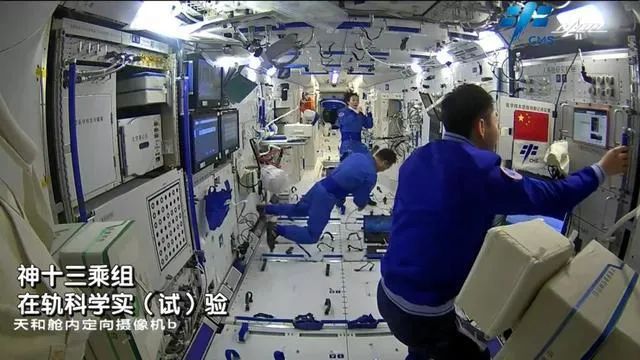
▲ Screenshot from the official video of China’s crewed spaceflight on November 21, 2021, showing the Shenzhou 13 crew conducting on-orbit scientific experiments. (Xinhua News Agency)
(2) Operation of the Space Station
The space station is a large integrated facility of mechanisms, electronics, and thermal systems, containing a large number of mechanisms and electromechanical products. Direct human operations are not only efficient but also make it easier to judge operational results. For instance, for the opening or movement states of products like valves and actuators, the ground typically uses “whether the open/close command was issued” or “whether a certain part of the mechanism triggered a pressure point switch” as the basis; due to the constraints of sensor principles and implementation methods, it is often difficult to directly determine whether the physical actions of the device’s moving parts are “in place”. Human operations can directly ascertain operational results based on handle positions, valve angles, and the spatial orientation of mechanisms in real time.
The greater advantage of humans on site lies in their rapid response capability. Once “actions are not in place,” they can quickly determine whether it is a fault in the actual physical actions or an issue with sensors or information transmission, and address it immediately. The physical actions of mechanical products are best assessed through “seeing is believing,” which is also why unmanned spacecraft increasingly install cameras, allowing ground personnel to directly judge the status of solar panels deploying, robotic arms moving, and other operations from images.
(3) Assembly and Construction of the Space Station and Other On-Orbit Facilities
We often liken the on-orbit construction of the space station to building blocks or houses in space. It is essentially a process of continuously increasing, splicing, or adjusting infrastructure, involving a large number of complex and precise mechanical and electrical operations both inside and outside the module, making it most suitable for humans to shine on site.
Last year, the International Space Station had two major operations that exemplified this type of work. One was the installation and upgrade of two sets of new solar arrays through multiple astronaut spacewalks conducted by the US module. The second was the connection of cables and installation of external facilities by Russian astronauts through spacewalks and in-module operations, making the recently launched “Nauka” multifunctional module a true part of the International Space Station.
Since the first module was launched in 1998, the assembly of the main structural truss of the International Space Station and the expansion of numerous modules have been completed by astronauts with the assistance of robotic arms. As of April 28, 2022, astronauts have conducted 250 spacewalks to assemble, maintain, and upgrade the space station.

▲ On April 28, 2022, Russian astronauts conducted the 250th spacewalk of the International Space Station to activate the new European robotic arm. (Image source: NASA)
2. Humans as Backups or Supplements to Machines
In crewed space activities, human-controlled operations are often used as backups or supplementary means to automatic operations. We can understand that human operations and automatic operations are two independent and fundamentally different heterogeneous controllers, and their combination can greatly enhance system reliability.
A typical independent backup design is rendezvous and docking. During most of the rendezvous process, the system needs to perform trajectory measurement and orbital calculations, which humans cannot accomplish. In the final stage of the rendezvous, the active spacecraft must perform six degrees of freedom control for position and attitude, where human visual and motor capabilities can play a critical role. In this phase, the automatic system uses radar or optical measurement devices to measure position and speed, optical sensors combined with 3D targets to determine relative attitude, and control computers to calculate control parameters and send control commands to the propulsion system; astronauts visually observe the target images through direct sight or cameras, using their three-dimensional vision to determine attitude and make handle operations based on their spatial motion sense and position. Such a design ensures that in the event of automatic system failure, humans can immediately take over control, ensuring safety and continuing the mission.
Human control as a supplementary design is commonly seen in robotic arm operations. During extravehicular activities assisted by robotic arms, large-scale transfers are usually conducted by computers performing path planning and execution, effectively avoiding obstacles and optimizing mechanism movements. When reaching the work point requires fine-tuning, on-site astronauts better understand their needs, and through direct observation can obtain more comprehensive three-dimensional spatial information than relying on camera images, thus this stage often adopts the approach of “listening to the working astronaut’s commands” for local position adjustments of the robotic arm. To improve efficiency, this command and execution are usually no longer conducted in an Earth-space collaborative mode but are instead performed by astronauts inside the module following extravehicular commands. The European Robotic Arm (ERA) operates more “on-site,” specially providing an operation box for extravehicular astronauts. Through the handles and buttons on the operation box, astronauts can operate the robotic arm like driving an excavator while working outside.

▲ China’s first manual rendezvous and docking was successful.
3. Responding to Emergencies is a Unique Human Advantage
The maintenance of on-orbit facilities that requires astronauts to perform is mainly the replacement or repair of hardware equipment, which cannot be achieved through “soft” means such as data injection or software upgrades and is very difficult for machines to execute. During the more than twenty years of flight of the International Space Station, astronauts have replaced expired mechanical pump groups, replaced faulty control moment gyroscopes, and upgraded nickel-hydrogen batteries to lithium batteries, covering a wide range of equipment maintenance tasks.
The greater role of astronauts lies in addressing issues that fall outside the design state and require on-site judgment based on specific circumstances. Typical examples include the five on-orbit repairs and upgrades of the Hubble Space Telescope, as well as the maintenance of the Alpha Magnetic Spectrometer (AMS) thermal control system on the International Space Station. To solve the lens assembly error of the Hubble Space Telescope, astronauts installed a custom correction lens; to free up installation space within the limited volume, they had to remove a relatively unimportant piece of equipment (the high-speed photometer). In the second case, engineers developed over twenty specialized tools, which were operated in space after ground testing, and based on the actual operations of astronauts during each spacewalk, subsequent task plans were formulated, ultimately completing the repair of the AMS cooling system piping.
Emergency rescue is the most severe fault that astronauts handle, not uncommon in the history of global crewed spaceflight. When the International Space Station had a cabin leak, astronauts isolated the cabin segments by closing the hatches, covering the suspected leak area with plastic sheets to locate the leak point; when a fire broke out on the Mir space station, astronauts extinguished the flames using fire extinguishers and then restored the air composition and repaired some equipment; the uncontrolled Salyut 7 space station was repaired by the Soyuz T-13 astronauts through manual docking. Thanks to the on-orbit maintenance conducted by astronauts, the Mir space station, designed for a five-year lifespan, operated for fifteen years, and the International Space Station remains technically viable for extension after over twenty years of operation.
“Adapting to changing circumstances” on-site and emergency rescue both belong to the realm of the “unexpected.” Once such abnormal situations occur, due to the significant difference between input data and training data, machines find it challenging to respond optimally. In contrast, humans rely on their knowledge, experience, and logic to make judgments, often solving problems and diffusing crises wisely.
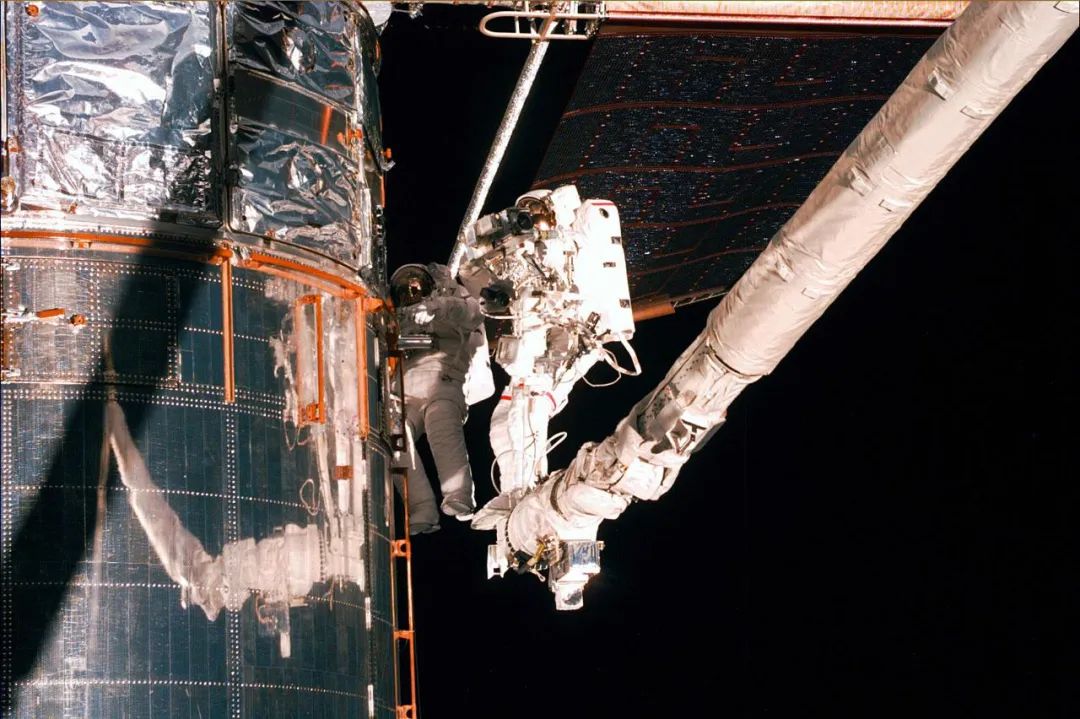
▲ In February 1997, American astronauts conducted extravehicular maintenance on the Hubble Space Telescope during the STS-82 mission (Image source: NASA/ESA)
4. Researching Humans Themselves is Also an Important Space Mission
Humans are the main subject of crewed space activities and also one of the research objects. From the one-day mission of Shenzhou 5 to the six-month stay on the space station, the continuous on-orbit flight time of Chinese astronauts has been increasing; studying people in space environments is not only the basis for ensuring the health and safety of current flight missions but also the prelude to future crewed moon landings and interstellar voyages.
Through comparative studies of physiological and psychological indicators of identical twins who stayed in space and on Earth for one year, NASA’s scientific team partially revealed the effects of spaceflight on human telomeres, cognitive abilities, gene expression, and more. China has also conducted in-depth research on the mechanisms of space medicine issues in conjunction with various crewed flight missions, developing efficient comprehensive intervention and protection measures. Space medicine experiments and space scientific research and applications, along with aerospace technology testing, constitute the three major application fields of the Chinese space station.
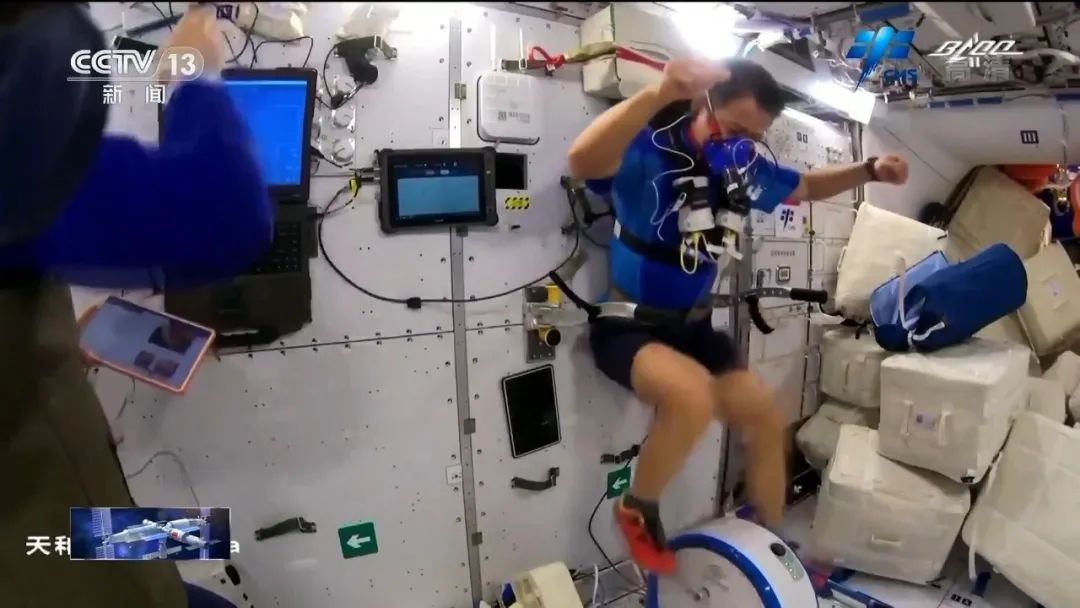
▲ Astronaut Nie Haisheng testing cardiopulmonary function in orbit during the Shenzhou 12 mission (Image source: CCTV)
Despite significant progress in brain science research, our understanding of the working mechanisms of the human brain remains very limited. The complex information processing and comprehensive judgment abilities seem to be a unique gift from the world to humankind.
Letting machines perform calculations with large volumes and relatively certain logic while allowing humans to engage in higher, creative, and even unpredictable activities has become a consensus in the fields of science and technology on Earth, and it is also the foundational design principle for countries around the world to develop crewed spaceflight and to enable humans to move from near-Earth to deep space.
Part Two: A Reliable System: The Best Platform for Humans in Space
Since the role of humans in space is irreplaceable, the fundamental responsibility of crewed spaceflight is to create a working and living platform for humans in space. This platform, while directly represented by crewed spacecraft, actually transcends the spacecraft itself; it is achieved through the optimized combination of human factors design and technical solutions of various engineering elements, allowing the entire system to reach the best state for serving “humans.”
As aerospace engineers, we need to ensure human safety through the design of spacecraft and their operating systems, establishing living conditions where humans can be comfortable above the basic survival environment, and only then can we design and build efficient workplaces and support conditions. All of this not only responds to the needs of crewed space missions but also reflects the latecomer advantages of China’s space station design.
1. Safety First in System Design
Ensuring the safety of humans in space is the primary task of crewed spaceflight. As a multi-system, multi-professional participating system engineering, various safety measures have been designed in the configuration and operation of the entire system around the requirement of ensuring human safety.
(1) Safety Logic of Multi-Module Space Stations
One major advantage of multi-module space stations is that each module can independently assume safety assurance functions, and when a local problem arises, it can ensure overall safety through physical isolation.
For example, in the functional distribution of the International Space Station modules, safety-related functions are backed up redundantly. Despite the technical difficulties and the inconsistency of the two countries’ technical routes, both the Russian and American modules have ensured that each is equipped with a regenerative life support system.
The Chinese space station uses the Tianhe core module as the platform control and management center to conduct unified control of the entire station. The Wentian experimental module backs up complete key functions such as energy management, information systems, control systems, and human environment, capable of taking over overall control of the station in the event of a failure in the core module. In response to major faults such as fire or loss of pressure in the core module, it is specially equipped with a complete regenerative life support system and emergency supplies, to prepare for astronauts to wait for ground fault handling and rescue for an extended period. The Mengtian experimental module also has equipment-level backups for key functions, further enhancing system safety. In terms of the safety of astronauts during extravehicular activities, the Wentian experimental module is equipped with a primary airlock, with the Tianhe core module node serving as a backup airlock. If the primary airlock encounters issues during the extravehicular process, astronauts can return to the module via the node module, ensuring the safety and reliability of extravehicular activities.

▲ The assembly process of the Chinese space station in orbit (Image source: China Manned Space Engineering Office)
(2) Lifeboat and Ultimate Safety Solutions
Once astronauts encounter safety issues, the ultimate solution is to return to Earth. The ground environment avoids all unsafe factors in space, and the guarantees available to humans on the ground are almost limitless compared to those in orbit. This “safest” principle requires that space stations must always be able to allow astronauts to return to the ground, leading to the concept of a “lifeboat”—the crewed spacecraft does not immediately withdraw after sending astronauts to the space station but remains docked, serving as a lifeboat for personnel on the station.
As many people as there are on the station, there must be as many lifeboats, consistent with the requirements for lifeboats on ships. In terms of mission arrangements, there are also a series of specific requirements and measures to ensure:
—There cannot be a situation where there are people on the station without a lifeboat, or where the number of people on the station exceeds the capacity of the lifeboats, temporarily or permanently. For example, if a rendezvous test is required, or if the spacecraft is temporarily separated and re-docked to change the docking interface, regardless of how many people are needed for the operation, the corresponding crew must all enter the spacecraft to ensure that if any issues arise during the mission, everyone is on the spacecraft and can return safely to the ground.
—The lifeboat cannot be completely powered off while docked; it must remain in a dormant state with monitoring and other equipment remaining powered on, ready to receive commands to wake up the entire spacecraft.
—The lifeboat must have necessary return supplies stocked, undergo regular power inspections, and astronauts must periodically enter the spacecraft for checks to ensure the spacecraft is in good condition and ready for use.
—In the event the lifeboat cannot return due to a malfunction, a new spacecraft must be launched as soon as possible to replace it.

▲ On October 16, 2021, the Shenzhou 13 spacecraft successfully docked with the Tianhe core module at the radial port. (Image source: China Academy of Space Technology)
(3) Before Launch, It is Called Ground Rescue Ship
The spacecraft that will immediately replace the malfunctioning lifeboat is the ground rescue ship. The long-term operation of the space station requires that the ground must have a continuously standby rescue spacecraft to truly ensure the safety of personnel in orbit at all times.
Starting from the Shenzhou 12 mission, China has conducted rolling ground rescue standby in conjunction with continuous missions. When Shenzhou 12 was preparing for launch, Shenzhou 13 was also at the launch site completing tests; after Shenzhou 12 was launched, Shenzhou 13 remained on standby as a rescue ship at the launch site, and upon receiving a rescue command, it could launch and execute the rescue in the shortest time; before the official mission of Shenzhou 13 began, Shenzhou 14 entered the launch site for testing… This cycle continues, with each spacecraft having a short and similar ground waiting time, avoiding a series of problems associated with long-term storage of dedicated rescue ships.
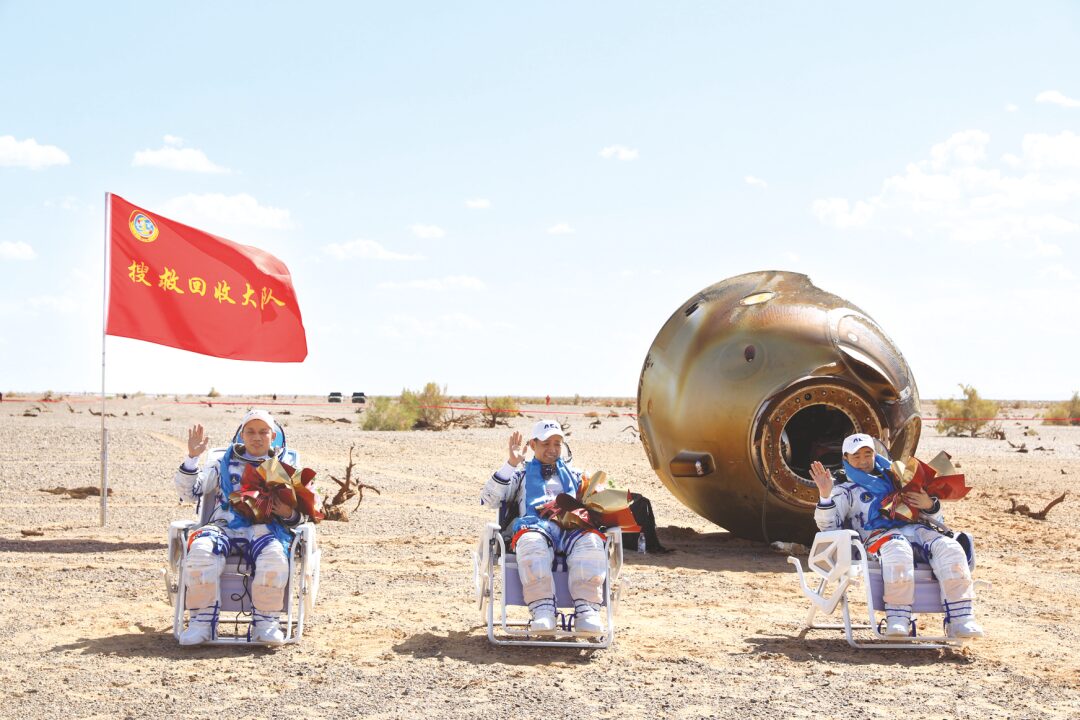
▲ On September 17, 2021, as Shenzhou 12 returned to Earth, Shenzhou 13 transitioned from a rescue spacecraft to an official mission spacecraft. (Image source: Xinhua News Agency reporter Ju Zhenhua)
(4) Orbit Design Aiming for Safe Return
The safest return to Earth is paramount, therefore the orbital design of the space station must create optimal conditions for quick returns under various circumstances.
—Using return orbits. Crewed space stations of various countries are located in orbits at an altitude of 340-450 km, which is the result of balancing the atmospheric protection against cosmic radiation and orbital decay factors, and because this altitude orbit has the characteristic of returning within 2-3 days. This means that the areas on the ground (including return landing areas and ground control stations) that the space station passes over repeat every 2-3 days, allowing for relatively fixed return flight procedures to be established. This is very beneficial for ensuring return safety, especially for emergency returns occurring at uncertain times.
—Designing to choose return landing areas. During normal returns, the spacecraft should land in areas with favorable geographic, climatic, and search-and-rescue conditions. China adopts a land return landing scheme, which imposes greater design constraints compared to the sea splashdown scheme because there are limited landing areas that meet the landing site conditions, and their geographic locations are fixed. This requires the orbital inclination to be designed so that the space station passes over the landing area as many times as possible during the return cycle. For instance, passing once a day means it can return to the designated landing area according to the normal procedure every day. To cope with the uncertainty of ground weather conditions, it is also necessary to consider setting up secondary landing areas far enough from the main landing area, where weather conditions may differ. When the space station operates stably and can provide sufficient safety and material guarantees, it can wait in orbit to avoid adverse weather on the ground, reducing reliance on secondary landing sites. In other words, it exchanges time (waiting for weather) for space (choosing another area to land).
—Designing to choose emergency landing areas. The setup of emergency landing areas addresses situations where the spacecraft experiences malfunctions while flying independently without the support of the space station and needs to land quickly to ensure astronaut safety. Here, “quickly” means the spacecraft must land safely before exhausting its onboard resources such as energy and oxygen. Considering the worst-case scenario, malfunctions can occur at any moment, and engineering must combine the characteristics of orbital reentry, selecting a sufficient number of suitable areas globally as emergency landing sites, ensuring that the spacecraft can land in these areas within the “quickly” timeframe and not in undesired locations.
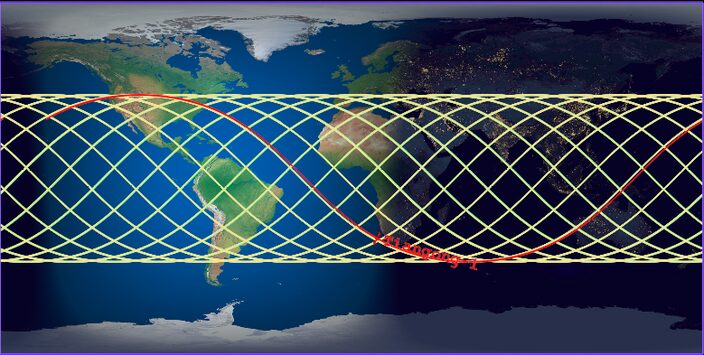
▲ Flight trajectory of the Tiangong-1 space laboratory (Image source: Phillyvoice)
(5) Safety Strategies for Crewed Lunar Exploration
Crews flying in low Earth orbit can return to the ground in about 45 hours in emergencies; even if they must return to the main landing area, it does not exceed one day. Therefore, “returning to Earth” has become a countermeasure for many emergency modes in low Earth flight missions. In the aforementioned incident of the Mir fire, the consideration was given to immediately abandon the space station to return, but ultimately the fire was controlled, and it was decided to first return three astronauts while leaving three to continue repairs.
However, lunar missions are different. Even without considering the work required for lunar liftoff and orbit changes, simply returning from lunar orbit to Earth orbit takes more than three days, which is too long for emergency situations. When discussing with Russian colleagues, they emphasized that if crewed lunar exploration is to conduct sustained work on the lunar surface, it is necessary to change the emergency strategies of low Earth orbit and establish a new emergency system.
In fact, various countries currently proposed long-term lunar exploration mission plans have designed lunar orbital space stations. One important role of the lunar orbital station is to serve as a temporary safe haven for personnel on the lunar surface in emergencies. Compared to the unknown environment of the lunar surface and the costs associated with propellant for landing, a more stable and resource-abundant space station can be constructed and operated in stable lunar orbit. From a safety perspective, such a configuration actually forms a safety system of “frontier exploration (lunar activities) – forward base (lunar orbit space station) – rear (Earth).”
2. Spacecraft as a Place for Survival in Space
Under the premise of ensuring safety, spacecraft must provide basic living conditions for humans.
(1) Atmospheric Environment
During orbital flight, humans spend most of their time in sealed modules, consuming oxygen, generating carbon dioxide and some harmful gases, while the equipment and experimental devices on the space station also release small amounts of harmful gases. Therefore, the cabin environment needs to dynamically control atmospheric pressure and composition. Since the Mir space station, long-term flying space stations have been equipped with regenerative life support systems; the Chinese space station has also installed systems for electrolytic oxygen generation, regenerative carbon dioxide removal, trace harmful gas purification, condensate water treatment, and urine processing, achieving a high material closure degree for human environmental control.
(2) Microbial Control
Human living environments will breed microorganisms. If not controlled, microorganisms not only threaten human health but can also corrode equipment. Therefore, microbial prevention and control are critical issues for long-term crewed flights, involving the safety of living environments.
Microbial control in space stations is also a system engineering task. The selection of antimicrobial and antifungal materials, cleanliness, inspection, and environmental control during the equipment production and module assembly testing process, along with purification methods such as air purification, water purification, and surface wiping after reaching space, are all necessary to ensure a healthy living environment for humans.
(3) Space Environment Protection
Cosmic rays pose a threat to human health. There are three ways to protect the human body: atmospheric protection, spacecraft protection, and control of flight duration. In terms of protection equivalence, Earth contributes the most; the Earth’s atmosphere and magnetic field in the low Earth orbit area can reduce the intensity of galactic cosmic ray radiation by 70%-90%; spacecraft use metal structures and rationally arrange equipment layout around human activity areas as effective protective measures; currently, astronauts from various countries typically do not fly for more than six months per mission to control overall radiation dose.
If the above three methods do not simultaneously meet the conditions, there will be risks of space environment effects:
—Extravehicular activities. During extravehicular activities, astronauts lose the protection of the spacecraft’s metal shell, and the accumulated radiation dose during extravehicular time must be calculated separately. Additionally, countries typically plan normal extravehicular tasks to avoid having astronauts in the South Atlantic Anomaly area during 6 to 8 hours of extravehicular activity—this area has a magnetic field strength 30-50% weaker than the surrounding regions, and the Van Allen radiation belt dips to 200 km; when the space station flies at 400 km altitude, it will encounter stronger radiation while passing through.
—Flexible inflatable modules. Bigelow Aerospace’s Bigelow Expandable Activity Module (BEAM) has been docked to the International Space Station for experimental application, and several other companies’ commercial space stations also adopt flexible module solutions. Flexible modules constructed with multi-layer new materials have significantly improved performance in insulation, space debris protection, structural strength, sealing, and internal scratch and puncture resistance, but due to their low material density, their protective effect against space radiation is still far inferior to that of metal. Therefore, BEAM is currently just an experimental module with a normal atmospheric environment, where personnel can enter but cannot stay long-term. The on-orbit performance of flexible inflatable modules is still under continuous evaluation.
—Deep space flights. Crewed deep space flights can last for months or even years, far from Earth, and with current spacecraft technology levels, it is impossible to guarantee the safety of radiation doses for crew members; the three protective measures are insufficient. The same issue exists for long-term work in environments without atmospheres, such as the lunar surface. Therefore, radiation protection measures for deep space vehicles and the construction of protective spaces using in-situ resources on the lunar surface are worthy of in-depth research.
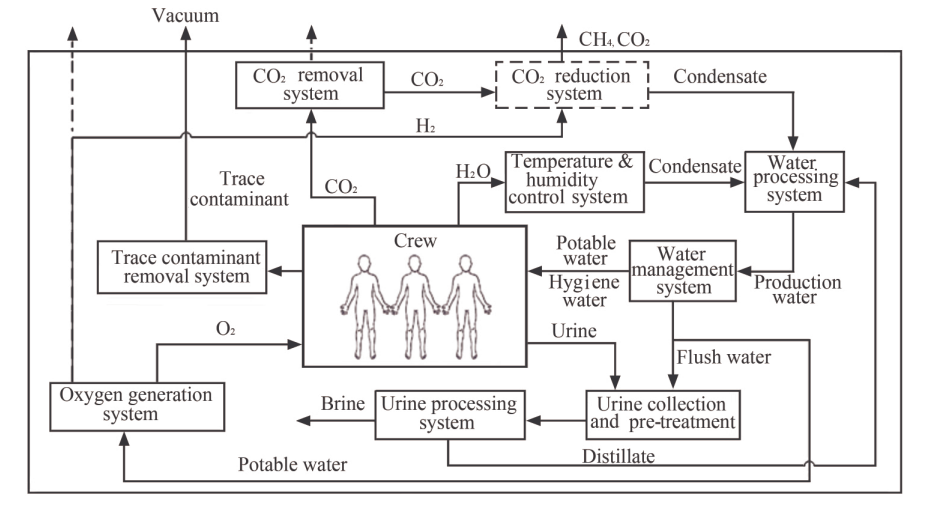
▲ Architecture of the regenerative life support system of the space station (Image source: Aerospace Medicine and Medical Engineering)
3. Space Life Can Be Better
Once survival issues are resolved, the next step is to improve living conditions for astronauts, allowing them to work better and stay longer. With the accumulation of experience in crewed spaceflight practice and advancements in technology, the living conditions on the space station have gradually evolved from merely ensuring sufficient hardware conditions to also considering physical and mental health.
The Cupola module on the International Space Station is an excellent design. It is a panoramic observatory protruding 1.5 meters from the module’s surface, providing a viewpoint for flight engineers during robotic arm operations, visiting spacecraft docking, and other tasks. More meaningfully, it allows astronauts who live in confined spaces for extended periods to gaze at the Earth and the stars, helping to regulate and soothe their emotions. The Cupola module should be seen as a result of both design philosophy and technological advancement; in the past, it was hard to imagine that someone would specifically develop a nearly 3-meter diameter, 1.8-ton panoramic skylight to be sent into space.

▲ The Cupola module on the International Space Station (Image source: NASA)
In terms of living conditions, the Chinese space station has introduced the concept of livability design, ensuring convenience for astronauts’ lives and psychological and physiological health:
—Living and working areas. The two areas are relatively independent, and specific designs have been made for spatial dimensions, lighting, colors, and signage. The living area includes bedrooms, kitchens, and bathrooms, with layouts and equipment configurations fully considering convenience and privacy. As a design requirement, each bedroom has a window, and both living and working areas have respective noise indicators and control measures.
—Exercise facilities. The module is equipped with fixed exercise facilities such as treadmills and bicycles, and astronauts are also provided with portable exercise equipment such as resistance bands and impedance exercise devices. Scientific in-orbit exercise helps astronauts maintain physical fitness and bodily functions, benefiting both in-orbit tasks and recovery upon return to Earth.
—Smart home management and entertainment. Based on a wireless Wi-Fi network, the project has designed work, life, and entertainment apps for astronauts, allowing for smart home management and material management through smartphones and tablets.
—Earth-space network. The Earth-space network ensures two-way audio and video, allowing astronauts to watch ground television programs and use network phones to communicate with family, teammates, doctors, and technical support staff. This truly embodies the idea of “neighbors across the distance.”
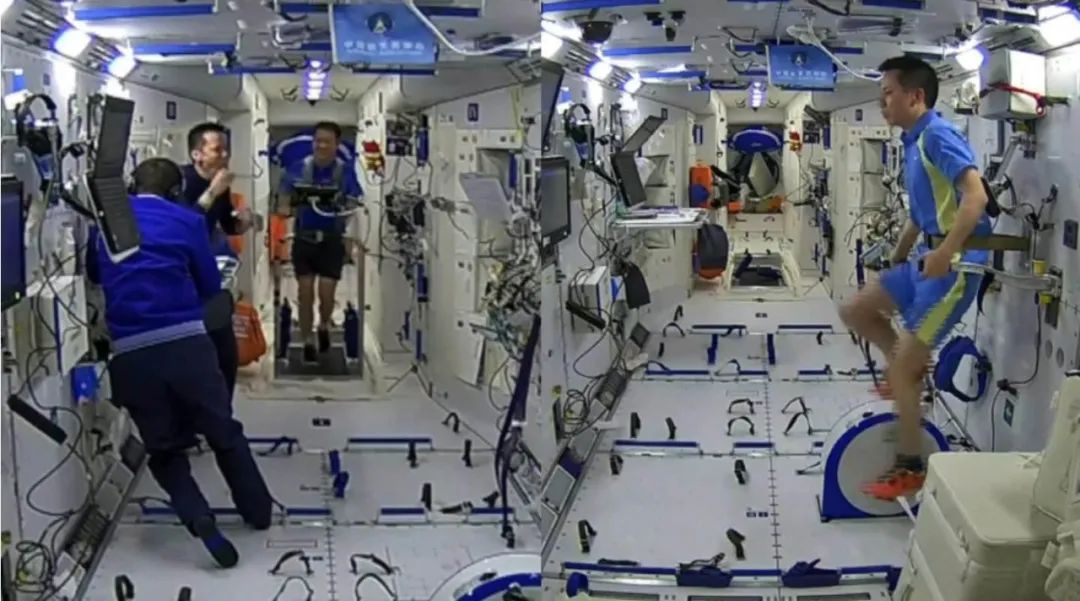
▲ Astronauts of Shenzhou 12 exercising in orbit (Image source: China Academy of Space Technology)
4. Going to Space is for Work
Going to space is to execute tasks. Under the premise of safety and livability, crewed spaceflight must design better workplaces and convenient working methods for astronauts.
(1) Human-Machine Interface Design
Ergonomic design must be conducted synchronously for the devices and interactive interfaces used by astronauts from the scheme stage. Along with the development of the space station, related products must undergo system-level to individual machine-level ergonomic verification and evaluation on the ground to ensure that astronauts can operate safely, efficiently, and conveniently once in space.
(2) Maintainability Design
To do a good job, one must first sharpen their tools. Since maintenance is an important part of astronauts’ work in orbit, the space station must carry out a series of designs aimed at meeting maintenance needs. The main tasks include:
—Identifying maintenance needs. Simply put, equipment that is relatively prone to failure and has a short lifespan, or important equipment whose failure would affect safety and mission, must be designed to be maintainable. The former includes limited-lifespan batteries and pumps, while the latter includes life support equipment. Conversely, if certain equipment is unmaintainable or the cost of maintenance is too high, it must be designed and manufactured to be sufficiently reliable, such as piping systems and mainline cable networks. This is similar to home renovations: faucets and light bulbs are replaceable, but the plumbing and electrical wiring embedded in the walls are typically not replaced and are not easily damaged.
—Equipment maintainability. For individual equipment, it must be ensured that astronauts can see and reliably operate it even in a weightless environment or while wearing extravehicular suits, and can effectively test and verify maintenance effects; specialized tools may be designed if necessary. The difficulty of maintaining extravehicular equipment is greater; to enable astronauts to perform corresponding operations while wearing extravehicular gloves, operation handles, cable plugs, etc., are all specially designed. During equipment installation and layout, it is necessary to consider that astronauts have sufficient operational space and lighting conditions.
—System support for maintainability. On-orbit maintenance cannot be conducted like on the ground where the entire system can be powered down; during maintenance, it must be possible to isolate faulty equipment while keeping the system operational. Just as when replacing a faucet, the upstream water valve must be closed, and when changing a light bulb, the circuit breaker for that room must be turned off while other rooms can still use water and electricity. Designs on spacecraft include: maintainable equipment having alternative equipment to continue functioning, or the equipment itself can be temporarily powered down without affecting system operation; the power supply system can be partially powered down for maintenance or replacement of faulty equipment while allowing other powered devices to maintain system operation; the information system must allow devices to be cut off and reconnected without causing network protocol conflicts.
—Tool design. Astronauts’ handheld tools, robotic arms, and even robots must be designed as tools. From the four extravehicular tasks already completed by the Chinese space station, we can see typical extravehicular operation tools and their performance. The astronaut crew efficiently collaborates with human-machine cooperation, controlling robotic arms to transfer personnel and equipment; extravehicular astronauts use fully functional tools to complete maintenance or assembly tasks; and on the outer wall of the space station, astronaut foot restraints are arranged to secure their bodies while working.
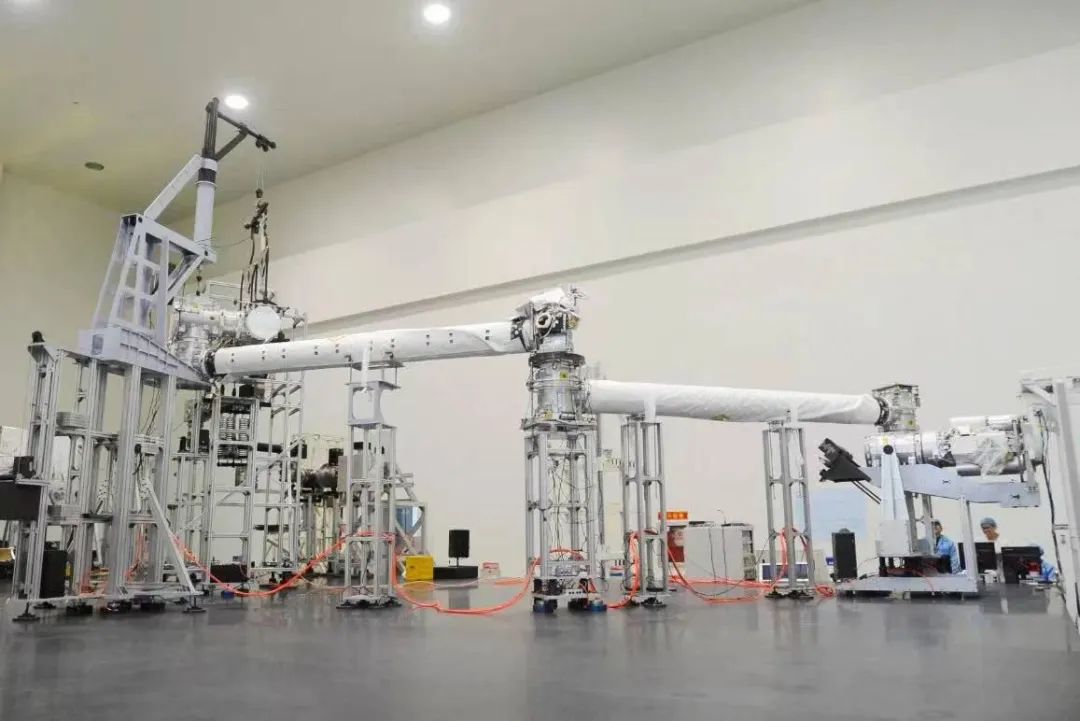
▲ The robotic arm of the Chinese space station during ground testing (Image source: China Academy of Space Technology)
(3) Space Port Design
The entire space station serves as a “good workspace” and “handy tool” for astronauts, and it can also become a space mother port for visiting spacecraft, providing service support. For example, based on the innovative model of co-orbital spacecraft servicing in orbit, the survey space telescope can temporarily dock with the Tiangong space station for propellant replenishment and equipment maintenance upgrades.
Compared to the enormous costs incurred by the United States in launching shuttles multiple times to repair the Hubble Space Telescope, the co-orbital service model is convenient and economical, greatly expanding the “multi-functional” capabilities of crewed spacecraft. This working mode also fully utilizes the strengths of both unmanned and crewed vehicles, avoiding conflicts that may arise from different operational states. The survey telescope operates as an unmanned satellite during routine operations, free from personnel interference, allowing for high-precision and high-stability attitude control, which is extremely beneficial for astronomical observations; when maintenance is needed, it docks with the space station, becoming part of the crewed spacecraft, allowing astronauts to perform relevant operations.
(4) Earth-Space Coordination Support
Astronauts do not fight alone in space. Efficient Earth-space coordination is a crucial guarantee for fully utilizing the strengths of both realms.
The return of Apollo 13 is a classic case: the spacecraft was nearing the Moon when an oxygen tank in the service module exploded, and the ground control center decisively canceled the lunar landing mission; with the support of the ground engineering team, astronauts implemented emergency power supply, air purifier modifications, and braking for return, ultimately succeeding in returning to Earth. The aforementioned BEAM inflatable module provides a contemporary example of Earth-space coordination: during its initial deployment, BEAM was halted due to friction between the soft fabric layers exceeding expectations; three teams—on-orbit astronaut crew, NASA team at the flight control center, and Bigelow’s development team—collaboratively completed fault location and resolution. Ground engineers observed the module’s status changes overnight, combining with astronauts’ on-site observations to pinpoint issues, and providing real-time guidance for astronaut operations, forming a large feedback loop of “astronaut operation—module changes—Earth-space coordination observations and judgments—discussions to form next operational advice.” During the second deployment, astronauts manually opened the inflation valve 25 times, successfully filling and deploying BEAM.
The core module of the Chinese space station has been in orbit for over a year. Based on completed extravehicular and in-module tasks, the operational mode under the support of a large Earth-space system has taken shape. In the future, the construction, expansion, upgrade, and on-orbit service applications of the space station will further enhance the capabilities of astronauts in orbit supported by ground professional teams, maximizing the role of humans in space.
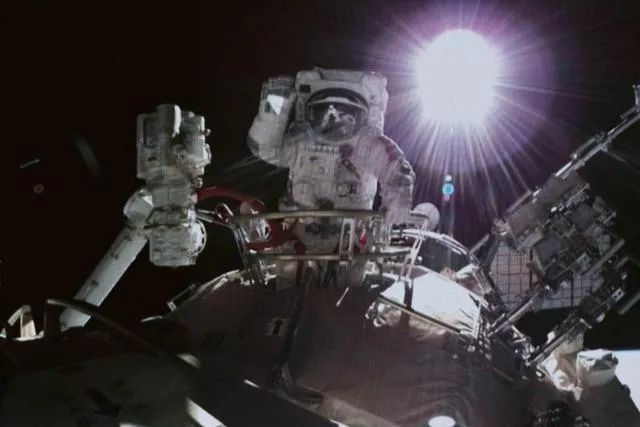
▲ On November 7, 2021, astronaut Zhai Zhigang’s extravehicular scene shot at the Beijing Aerospace Flight Control Center (Image source: Xinhua News Agency reporter Guo Zhongzheng)
For thousands of years, technology has changed the primary forms of human labor and further highlighted the intellectual advantages of humans. The updates in technology and the progress of humans move forward in a dynamic complementarity and mutual adaptation. Humans continuously create more advanced technology with their wisdom, and they must enhance themselves to keep pace with the speed of technological iterations; technology extends human capabilities and expands their living space, providing better conditions for the comprehensive development of humans.
This is the significance of humans in space.
The era of the Chinese space station is gradually unfolding. Humans have achieved the space station, and the space station will also achieve and elevate human value and dignity; humans are part of crewed spaceflight, and together with crewed spaceflight, they form a larger system, jointly exploring the margins and questioning the world.

Further Reading



Editor: Wang Xinrong
Proofreader: Cui Yicong